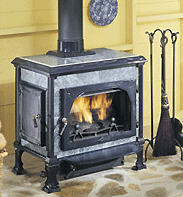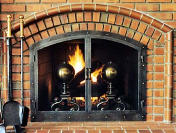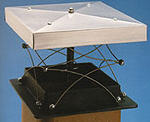Wood Pellet and Corn Stoves
 Overview
Overview
The use of wood stoves and fireplaces is a highly emotional issue. Whether the use is aesthetic/mood setting or the primary source of space heat, the true cost of heating with wood will always be an arguable topic. Here are some general statements that most would accept as true:
- fireplaces are poor heat sources, but set moods better than any other heating system
- wood stoves with proper air control can be very efficient heat sources
- the existence of wood-fired equipment make house insurance rates higher
- if the firewood is purchased, it is not likely an economical investment
Operation
 Venting
Venting
Wood stoves must be vented into a clay-tile-lined masonry chimney or metal flue pipe rated for wood fires. Wood stoves can NEVER share a flue with other appliances. The type of flue used will determine the spacing between the flue and combustible materials, such as wood framing. The height of the chimney or flue above the roof is dictated by code and required for good draft. Typical requirement is 3′ above the roof line where the chimney exits the roof and at least 2′ above any roof or building part within 10′ of the chimney.
Clearances
Code will dictate every dimension of where a wood stove can be placed. Distance from floor to stove, stove to ceiling, and stove to wall – in all directions, will depend on the type of stove and the type of construction materials. Clearances can be as much as 36″ for non-insulated stoves to combustible materials.
 Combustion Air
Combustion Air
If it is possible, efficiency is improved when using outside combustion air. This is possible with air-tight wood stove designs and fireplaces with inserts and glass doors. Unlike other fuels, it is nearly impossible to get wood to burn without lots of extra oxygen. Using outside combustion air also makes it possible to reduce flue losses during cool-down and unused periods – because the air lost up the flue is NOT heated inside air, but outside combustion air.
All new stoves are built to accept outside combustion air. EPA certified stoves are required to have outside combustion air.
Fuel
The BTU content of firewood varies significantly with the species and moisture content. Estimating the BTU content is important for determining economic decisions, but since most users of wood are not concerned about economics and/or the fuel is “free”, it really doesn’t matter.
If it does matter, wood has 4,000 to 7,000 BTUs per pound and 12 – 24 Million BTUs per cord. Dry hardwood has the highest BTU content making it the most desirable heating wood.
Most cellulose-type products, such as corn and various wood pellets, when dry have 7 – 8,000 BTUs per pound. Pellets may have a slightly higher BTU content if they have been blended with other materials.
Emissions
In 1988 the U.S. Environmental Protection Agency (EPA) enacted rules for cleaner operation of wood stoves. Now, all new stoves sold in the U.S. are required to be designed and tested to meet strict emission control and efficiency standards.
Note: Certain types of stoves, such as cook stoves, or stoves with a very high fuel-to-air ratio (which are not very effective as heaters, but often don’t emit much smoke), are exempt from the EPA requirements.
The primary emission of concern from wood stoves is carbon dioxide, and unburnt carbon in all forms (dark smoke).
In most EPA-certified stoves, primary air enters the stove through a long, thin slit across the top of the firebox, providing a widely-distributed flow of air into the stove. This creates a better mixture of oxygen with the fuel load for more efficient primary combustion.
Then, instead of allowing the combustible gasses emitted by the fuel load to escape up the flue, EPA-certified stoves utilize a new, second phase of burning: the burning of the gasses. This is accomplished either by means of a catalytic combustor or by means of a (non-catalytic) secondary combustion air system.
How EPA-stoves accomplish this second phase of combustion categorizes them as catalytic or non-catalytic stoves.
Some areas with strict air emissions codes may require that a wood stove be installed with a catalytic convertor. A catalytic convertor, similar in function to automobile versions, reduce emissions by further burning carbon. EPA requirements do NOT mandate the use of a catalytic combustor. Stoves simply have to pass the test, and it is up to the manufacturer to come up with a design that will pass.
Source: Emissions data from www.chimneys.com (see link below for much more information)
Efficiency
Efficiency is an estimate based on the potential BTUs in the wood fire delivered to the space to perform useful heating. Heated indoor air that is used for combustion and lost up the chimney during and after combustion is a deduction to efficiency.
- Open fireplaces -0 to 10%
- Fireplaces with glass doors 10 – 20%
- Fireplaces with air-tight inserts, outside combustion air, and power heat circulation 20 – 60%
- Wood Stoves with air-tight seals and outside combustion air 30 – 60%
- EPA Certified wood stoves 60 – 75%
Tips to Improve Efficiency
- Install glass doors or an insert in fireplaces
- Never operate with fireplace doors open
- Use outside combustion air where possible
- Burn only dry/seasoned wood
- Keep chimney/flue pipe clean of creosote and soot
 If optional, do not operate during the coldest weather or periods of high wind
If optional, do not operate during the coldest weather or periods of high wind- Keep dampers in good working order and closed during periods of non-use
- If damper does not seal tightly, stuff fiberglass batt insulation into fireplace chimney to stop air loss or add an EXTERNAL chimney damper to the top of chimney/flue, if design allows
- If optional, do not operate during times of non-occupancy
- Burn the fire hot and then shut it down when no longer needed; a slow, smoldering fire produces the most creosote, soot and potential condensation
More Information
Wood Stove Safety by Michigan State University atwww.msue.msu.edu/msue/imp/mod02/01500596.html
Ecofire.com is a good web resource that includes a lot of wood and stove informationwww.ecofire.com This site also contains links to many other wood-fuel related web sites.
Chimneys.com is a good web site that features information on all aspects of wood stove and fireplace information at www.chimneys.com
Source: Text Bob Fegan 12/2008 based on information contained in the web sites referenced and linked above;
© 2008 Energy Solutions Center
400 N. Capitol Street NW
Washington, DC 20001 All rights reserved. Legal Contact our webmaster
